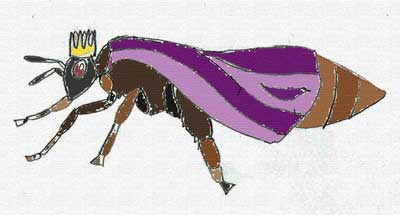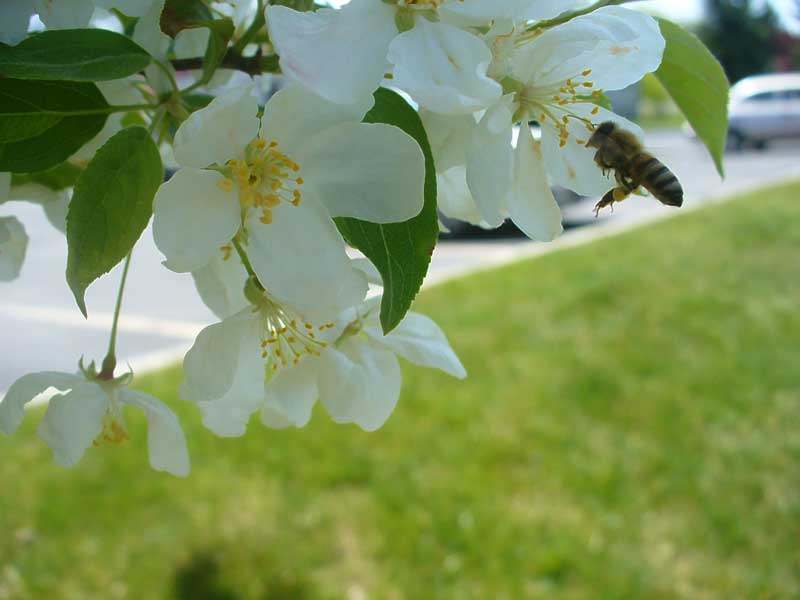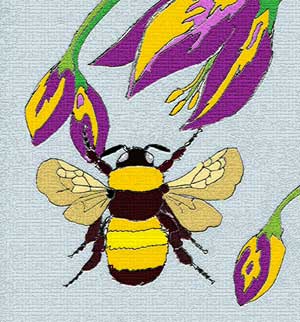Eight Common North American Bee Families
Learn more about bees!
Below are my summaries of some North American bee families (all are native bees except honeybees and orchid bees). To see excellent identification photos of the various bee families check out BugGuide. I've added a link to each family that goes to the appropriate insect photos in BugGuide. Even if you are not into bee portraits, take a look at the gorgeous incandescent green orchid bee.
For the lowdown on which bee comes out tops in pollinating see Bumblebee vs Honeybee Smackdown.
1) Honeybee (Family: Apidae):
These are domesticated social bees that pollinate our crops and provide us with honey. Honeybees are not native to North America; they were imported from Europe. There are ten species of honeybees worldwide. Honeybees have large and well organized hives with a distinct social structure. Some domesticated hives have over 80,000 bees! Each worker bee (all workers are female) has specific tasks to complete. Honeybees are the superstar of the bee kingdom; mainly because we humans love honey.
There are three types of bees; queens, drones and workers. 
Picture: It is good to be the Queen bee.
The queen bee is bigger than the other female honeybees. There is only one queen per hive and her mission in life is to lay eggs. She can lay over 1,500 eggs per day. Unlike other honeybees the queen can use her stinger more than once (it is good to be queen).
Queen bees are made by feeding bee larvae royal jelly through out her larval development. Royal jelly is high in protein. Other larvae only get royal jelly the first 2 days after hatching. Queens produce pheromones that unites the bee tribe socially under her rule.
Drones are male bees whose sole purpose in life is to loaf around and mate with a new queen. Drones have large eyes to help them keep their eyes on the queen during their mating or nuptial flight. These male bees are fed by the worker bees. To avoid wasting food on drones during the winter, the worker bees drive them out of the hive in the fall. This is pretty easy to do since male bees have no stinger.
Picture: A working honeybee.
Worker bees are all sterile females. As young adults worker bees are known as 'house bees' and take care of hive cleaning, comb construction, baby-sitting, regulating the hive temperature, meeting the queen's every wish and defending the hive from intruders.
When a house bee gets older she is promoted to field bee. Field bees forage outside the hive for nectar, pollen, water and plant resins used to make the hive. Worker bees have an extra stomach to carry honey or nectar, a pollen basket made of specialize hair on their legs to carry pollen, and special glands on their stomach that secrete beeswax.
Bees make a honeycomb which consists of hexagons cells made of beeswax. Honeycomb is a useful structure that is used to store pollen, make honey from nectar, ferment beebread and raise baby bees. When honeycomb is used as a brood comb, the queen lays eggs in the comb.
Eggs take 3 days to hatch. Fertile eggs become workers while unfertilized eggs become drones. Workers called nurse bees inspect and feed larvae when they hatch. Larvae forms a pupa 8-9 days after hatching. Workers bees pupate for 12 days (lazy drones take 14.5 and ambitious queens only take 7.5 days).
In human made hives a 'queen excluder' is used in the hive to prevent the larger queen from reaching some of the honeycomb. No eggs are laid in this honeycomb and it is used to store honey for food for bees or humans. Bees do not hibernate and they need stored food to eat during winter.
2) Bumblebee (Family: Apidae):
Bumblebees are furrier, fatter and just plain cuter than honeybees. They can be recognized by their bright colors and lazy clumsy flight. Bumblebees live in small colonies (50-400 workers) or may be solitary. They drink flower nectar or fruit juices and feed their babies honey. These big bees are peaceful and prolific pollinators.
Picture: Bumblebee visiting flower.
Unlike honeybees, only fertilized bumblebee queens overwinter. They find a dry protected area such as in a hollow tree to wait out the cold weather. In the spring the queen selects a nest site and lines it with grass or dried plants. She collects pollen and nectar to make 'bee bread' for her offspring. Normally she lays 5-20 eggs. The queen cares for the larvae until they pupate and new daughters emerge. The offspring will all be worker bees and will take over hive management and foraging so the queen can concentrate on egg laying.
Bumblebee vs Honeybee Smackdown
- Due to their long tongue, some bumblebees can pollinate flowers that honeybees cannot.
- Bumblebees can fly and pollinate plants at lower temperatures than honeybees. Bumblebees have been recorded flying at below zero and during raining or foggy weather! This is because bumblebees can generate heat both chemically and through a 'shivering' muscle action.
- Bumblebees work extended hours when compared to honeybees.
- Bumblebees will go to flowers that only have pollen (honeybees want nectar and pollen).
- Bumblebees employ 'buzz pollination' behavior where they grab the flower by the pollen structure and buzz their wings. This shakes loose more pollen (sometimes it literally 'explodes' and covers the bee with pollen). Some native plants, such as tomatoes and blueberries, need buzz pollination to set well.
- Bumblebees are gentle and do not like to sting unless they feel their nest is threatened.
- Bumblebees are really cute.
- Bumblebees are used to pollinate inside greenhouses.
- Bumblebees are native bees while honeybees are imported.
So why do honeybees get all the press?
- Honeybees make enough honey for us to share some.
- Honeybees are domesticated and can be moved around to pollinate multiple crops.
- Honeybees can pollinate a lot of plants since they are more numerous than bumblebees.
3) Digger Bees, Orchid Bees, Carpenter Bees and Cockoo Bees (Family: Apidae):
Digger bees are nonaggressive, solitary and nest in soil. Queen digger bees are hard workers that dig an underground burrow, line it with wax, stock it with collected pollen and nectar, and lay eggs near the food source. You can spot a digger bee's house by the mound of dirt around the nest's entrance. The bee offspring have to dig their way to the surface.
Males commonly emerge before the females and than spend their time cruising around the nesting grounds waiting for gals in search of some masculine companionship. Some species of male digger bees can smell the female emerging from the ground and 'help' her out of the ground by digging down to meet her.
Carpenter bees are long lived, large semi-solitary bees that carve out nests in old dead wood. To protect your wood home or deck from these bees, cover bare wood with a paint or varnish. Since these bees can live up to three years, often a mother and several young daughters share a nest.
After chewing a nest, the carpenter bee stocks it with pollen and nectar 'bee bread' and lays eggs. Like bumblebees, carpenter bees practice buzz pollination to shake loose pollen from plants. Carpenter bees can also store pollen in their stomach and bring it back to the nest.
Male carpenter bees will hover around nests but cannot sting. They attempt to 'defend' their territory by flying at people but cannot harm you. Female carpenter bees can sting but are not aggressive, do not defend their nests and very rarely sting unless handled.
Orchid bees are beautiful bees that come in a gorgeous array of metallic colors. These bees can fly over 30 miles in a single trip. Male orchid bees fly far and wide to collect scents from exotic flowers which they store in a special cavity in their hind leg covered with waxy leg hairs. As you may have guessed by the name, one of the flowers they visit is the orchid. Some orchids depend on these bees for pollination. Males use their scent banquet to attract females.
Sadly almost all orchid bees live in South and Central America. Only one species, the green orchid bee, Euglossa dilemma has made its way to Florida. It is roughly the size of a honeybee and is nonaggressive. Females like to nest in enclosed areas and seal off their nest with a mixture of plant debris and resin. Like many Florida transplants, this solitary bee may have communal nesting sites.
Cockoo Bees are the black sheep of the bee family tree. These sneaky bees do not make their own nests. Instead, like the cockoo bird, they sneak into another bee's underground home and lay their eggs. The unwitting foster mother takes care of the Cockoo larvae. The Cockoo bee may kill the other bee's eggs or larva or leave them. In addition, the cuckoo larvae often eat any 'step siblings' therefore getting the lion's share of the food and attention.
Female cockoo bees do not have pollen carrying structures. They have no need to transport pollen since like Maisie the Lazy Bird (from Horton Hears a Who) they fly off after leaving their egg with a stranger. Adult cockoo bees eat nectar and it is uncertain how effective they are as pollinators.
4) Leafcutter and Mason bees (Family: Megachilidae)
Leafcutter bees usually nest in existing holes such as hollow stems or cut off canes. These gentle bees get their name due to their habit of cutting out small round and elongated holes in plant's leaves. These holes don't normally damage the plant. Leafcutter bees line their found homes with pieces of leaves, overlapping them like they are rolling a cigar. Round pieces are used for the bottom of the tube while oval pieces line the sides of the nesting tube. Don't begrudge leafcutter bees their leaves though, one leafcutter bee can pollinate as well as 20 honeybees.
Unlike honeybees, leafcutter bees do not have pollen baskets on their hind legs. Instead they collect pollen on their abdomen or stomach. Queen bees gather pollen and nectar to provision their nest for the young. They add food to the bottom of their nest hole and lay one egg. That cell is sealed with a round leaf piece and they repeat the process. The larvae develop into adults and overwinter in their brood cells. Once spring appears the bees chew through their home to emerge to begin a new cycle.
Mason bees also like to nest in natural cavities, tubes, reeds or holes. Unlike most other bees, mason bees use mud or chewed plant debris to remodel their new house. After constructing a suitable and tubular abode, the queen bee packs the bottom of the nest with pollen and nectar. One egg is laid and it is sealed with mud. The female repeats this process until her nest cavity is filled with small 'cells' with eggs and food. Larvae hatch, eat the food and form a pupa. They hibernate in the cocoon state and hatch in spring.
Mason bees are very nonaggressive and don't sting unless squeezed or sat on. Due to their peaceful nature and great pollinating skill many people try to attract mason bees to their garden. You can easily buy or make mason bee houses out of wood, or recycled paper, or just about anything (here's a fun website with good videos and photos on how to make all sorts of mason bee houses) to attract these helpful native bees to your yard.
5) Mining Bees (can also be called Digging Bees) (Family: Andrenidae):
Mining bees are solitary ground nesting bees which evacuate nests in exposed well drained soil. Usually the female digs a main vertical tunnel with secondary horizontal short side tunnels. Normally there will be dirt piled around the outside of the tunnel like an ant's nest. The queen bee stuffs the side tunnels with pollen and nectar and lays a single egg in each area. These bees are harmless pollen eaters and very peaceful; you will have to step on or grab one to provoke it into stinging.
6) Sweat Bees (Family: Halictinae):
Sweat bees are small nonaggressive bees that nest in either the soil or rotten wood. They get their nickname because they are attracted to the salt in sweat and can bother sweaty people by swarming around them. These bees can come in a striking green metallic color. Most sweat bees are solitary but a few species are more social, nesting together.
Like almost all bees, sweat bees are great pollinators and collect both pollen and nectar to feed their young. Sweat bees dig vertical nests with side passages. Queen bees provision these side tunnels with pollen and nectar before they lay a single egg in each tunnel. Sweat bees rarely sting and when they do the sting intensity is almost painless (they have very small stingers).
Is it or isn't it a bee? What you think is a sweat bee may be a syrhid fly, a bee mimic also attracted to sweat!
7) Plasterer and Masked Bees (Family Colletidae):
Masked bees (also called yellow faced bees) are peaceful but primitive bees. There are almost 500 species of masked bees worldwide. Almost all advanced bees are hairy with specialized pollen gathering hairs on their legs or abdomens (sometimes called a pollen basket on the legs). Masked bees, however, are fairly hairless, shiny and resemble slender wasps. In fact, these furless solitary bees have no pollen carrying hairs at all. They swallow the pollen, carry it back to their nest in their crop and than regurgitate it into the nest cell.
Masked bees are named for their prominent bold yellow/white mask-like marking on their face. These small bees have weak mandibles and cannot make their own home. Normally they nest in existing tunnels or cracks in dead wood as well as in plant galls and plant stems. Some species even use old and abandoned bee and wasp nests.
Masked bees line their nests with secretions that resemble cellophane. The polyester like compound is secreted from the Dufour's gland on the abdomen. The queen bee places pollen and nectar in the bottom of the nest, lays an eggs and than seals the cell up with her cellophane secretion. She repeats this process until the nest is filled with egg cells. Larva overwinter in cocoons but don't pupate until May.
Plasterer bees (also called polyester or cellophane bees) are solitary bees that nest in the ground or in pithy plant stems. There are around 120 species of plasterer bees in the United States of America. Plasterer bees dig their nest sites in the sides of earthen walls. Usually the bee will tunnel upward for a while before branching sideways.
Like masked bees, those docile bees line their nests with thin translucent secretions that resemble cellophane and contains macrocyclic lactones (also found in polyester). The bees secrete their building material from a special gland on their abdomen and spread it around with their short forked tongue. It is this characteristic that gives them their nicknames "plasterer bee' or 'polyester bee'. The water proof nest lining prevents nectar from leaking into the soil and hinders dampness and mold.
Plasterer bees do not roll pollen/nectar balls (bee bread) to feed their offspring. Instead they collect and feed larva liquid pollen. After laying an egg on the liquid pollen the bees spread a substance called linalool on the eggs. This substance is secreted from their mandibles and is an effective fungicide and bactericide. This protects the egg and allows the plasterer bee to nest in wet areas. These bees like to forage in early dawn or dusk.
8) Melittid Bees (Family: Melittidae):
Melittid bees are a small group of highly specialized primitive short tongued bees. Many but not all species are oligolectic (it means that they are really picky about what plants they feed from and visit). These small to medium sized black colored bees are found in the temperate zones of both North America and Africa.
Melittid bees are solitary ground nesters who dig irregularly shaped burrows. One unusual feature of this family is that their nest are not lined or waterproofed. Queen bees place balls of food in a roughly shaped soil cell chamber and lay an egg on it.
Some melittid bee species specialize in collecting floral oils from flowers. They collect the oil with specialized short dense tarsi hairs on the front legs and store the oil on fine, dense plumose scopal hairs on the tibia. These bees use oil to feed their larvae. The floral oil is mixed with pollen and rolled into a ball shape. Oil collecting Melittid also may use floral oil to line their burrows causing the walls to turn a characteristic green color.
